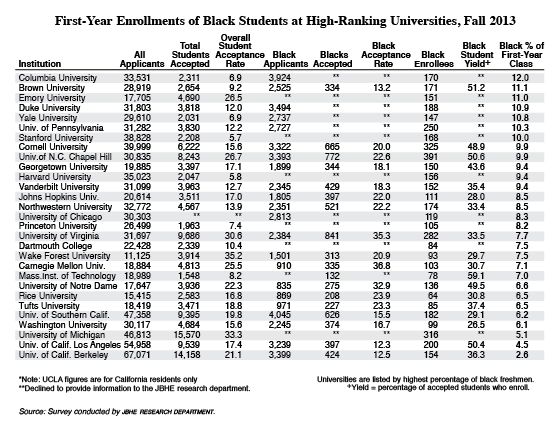![]() Once more, this year The Journal of Blacks in Higher Education has completed its survey of admissions offices at the nation’s highest-ranked research universities. For the 21st consecutive year, we have calculated and compared the percentages of African-American students in this fall’s entering classes. As in the past, our survey publishes information on the total number of African-American applicants at the various institutions, their acceptance rates, enrollment numbers, and yield rates (the percentage of students who eventually enroll in the colleges at which they were accepted).
Once more, this year The Journal of Blacks in Higher Education has completed its survey of admissions offices at the nation’s highest-ranked research universities. For the 21st consecutive year, we have calculated and compared the percentages of African-American students in this fall’s entering classes. As in the past, our survey publishes information on the total number of African-American applicants at the various institutions, their acceptance rates, enrollment numbers, and yield rates (the percentage of students who eventually enroll in the colleges at which they were accepted).

Six years ago Columbia University headed the JBHE rankings for the first time. Now, for the seventh year in a row, Columbia has the highest percentage of Black first-year students among the 30 highest-ranking universities in the nation. There are 170 Black freshmen at Columbia this fall. They make up 12.0 percent of the incoming class.
Only nine years ago in 2004, Blacks made up only 6.8 percent of the entering students at Columbia University. In 2010, there were 202 Black first-year students at Columbia. They made up 14.5 percent of the incoming students. This was the highest percentage of Black students in the entering class at a leading research university in the history of the JBHE survey.
Brown University ranked second in our survey this year, the highest position ever achieved by the Ivy League institution in Providence, Rhode Island. Last year Brown was in sixth place in our survey. There are 171 Black first-year students at Brown, making up 11.1 percent of the total.
Emory University in Atlanta finished a close third with an entering class that is 11 percent Black. Emory moved up from ninth place last year.
For the past two years, Duke University finished second in the rankings. This year Duke ranks fourth in our survey. The percentage of Black students in the entering class at Duke dropped slightly from 11.5 percent a year ago to 10.9 percent this year.
Yale University holds the fifth spot with an entering class that is 10.8 percent Black. In 2012, the first-year class at Yale was 9 percent Black, which placed the university eighth in our rankings.
The University of Pennsylvania dropped from third place in last year’s survey to the sixth spot this year. The percentage of Black students in the entering class at Penn dropped slightly from 11.1 percent in 2012 to 10.3 percent this year.
There are 168 Black first year students at Stanford this year. They make up 10 percent of all entering students. All of the other top research universities in our survey have entering classes that are less than 10 percent Black.
The University of North Carolina at Chapel Hill has led our survey six times. Two years ago the university ranked in third place. This year the university drops to a tie for eighth place with Cornell University.
Georgetown University, Harvard University and Vanderbilt University are tied for the tenth position with entering classes that are 9.4 percent Black. All other universities in our survey have a freshman class that is less than 9 percent Black.
The bottom two places in our survey belong to the UCLA and the University of California at Berkeley, universities that are prohibited by state law from considering race in their admissions decisions. At the University of Michigan, which also is prohibited by state law from considering race in admissions, the percentage of Blacks in the entering class dropped slightly to 5.1 percent. This is significantly below the level of Black enrollments that existed before that state enacted a ban on race-sensitive admissions. A federal appeals court has ruled that the state ban violates the U.S. Constitution. But the ban remains in effect until the U.S. Supreme Court decides the case.
Gainers and Losers

Here is some very good news. For the 29 high-ranking universities for which we have data for both this year and last, 20 universities showed gains over last year in Black student first-year enrollments. Only eight high-ranking universities had declines in their number of entering freshmen who are Black. The exact same number of Black first-year students entered Rice University in Houston this year as was the case a year ago.
Last year, the largest decline in Black first-year students was at the University of Virginia. There, the number of Black first-year students dropped from 284 in 2011 to 188 in 2012. But last year appears to be an aberration. This year, the University of Virginia posted the largest percentage gain. There are 282 Black first-year students on campus this fall, an increase of 50 percent.
Five other leading research universities posted one-year gains of at least 20 percent in their number of Black first-year students. Tufts University, Cornell University, and Emory University all posted gains of at least 25 percent. Notre Dame and Yale has one-year gain of better than 20 percent.
The largest percentage declines in the number of Black freshmen occurred at the University of Southern California, Columbia University, and the Massachusetts Institute of Technology. (Update: The University of Southern California informed JBHE in April 2014, that it had made an error in reporting data for 2012. The 2012 data included transfer students whereas the 2013 was only for first-time entering students. Therefore the 2012 figure in the accompanying chart should be 180 and not 248. Thus, there was a slight increase in Black first-year students from 2012 to 2013.)
A Note on Methodology
Before we continue with the results, it is important to mention how the U.S. Department of Education collects data on the race of undergraduates. Before a change was made several years ago, students who reported more than one race (including African American) were included in the figures for Black students. This is no longer the case. Thus, students who self-identify as biracial or multiracial with some level of African heritage are no longer classified as Black by the Department of Education.
JBHE surveys have always asked respondents to include all students who self-identify as having African heritage including those who are actually from Africa. JBHE has always maintained that biracial, multiracial, and Black students from Africa add to the diversity of a college campus. And including these students in our figures offers college-bound Black students a better idea of what they can expect at a given college or university. In order that we can compare our current data to past JBHE surveys we have continued to asked colleges and universities to include all students who identify themselves as having African heritage.
Back to the Numbers
It is well recognized that the percentage of Black applicants who actually receive invitations to join the freshman class is a valuable gauge of an institution’s commitment to racial diversity. Yet this figure is regarded as the most sensitive of all admissions data. This is particularly true for some of the very highest-ranked institutions.
Of the 29 highest-ranked universities in our survey, 12 declined to reveal their Black student acceptance rates. Unquestionably, public and private litigation threats to affirmative action policies in college admissions have been a factor in producing this sensitivity. With this in mind, admissions officers — who on the whole are solidly supportive of affirmative action — have apprehensions when statistics on Black admissions are made available to the public. There are standard concerns too that racial conservatives on faculties and among alumni and trustees may interpret the figures as suggesting a so-called dumbing down of academic standards and a favoring of “unqualified” Blacks over perhaps more qualified Whites.
But, at the same time it is critical to keep in mind that an institution’s high Black acceptance rate often indicates nothing more than the fact that the admissions office of a given institution has a very strong and well-qualified Black applicant pool.
At 12 of the 17 universities that supplied acceptance rate data to JBHE, the Black student acceptance rate was higher than the acceptance rate for all students. In some cases the differences were significant but larger disparities have been seen in prior surveys. Five of the high-ranking universities we surveyed had Black acceptance rates that were in fact lower than the overall acceptance rate. At the University of California at Berkeley and the University of California at Los Angeles, both of which were prohibited from taking race into account during the 2013 admissions process, the Black acceptance rate was significantly below the rate for all accepted students.
In many past surveys, Harvard University and Stanford University posted the highest Black student yields, often in the range of 65 to 70 percent. This year neither institution provided yield data to JBHE. Of the 18 universities that reported Black student yield, the highest rate of 59.1 percent was at the Massachusetts Institute of Technology.
Brown University, the University of North Carolina at Chapel Hill, and the University of California at Los Angeles all reported Black student yields of more than 50 percent. Universities where the Black student yield was below 30 percent were Washington University, John Hopkins University, the University of Southern California, and Wake Forest University.











